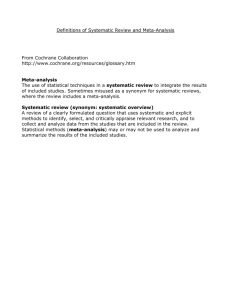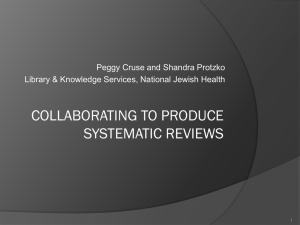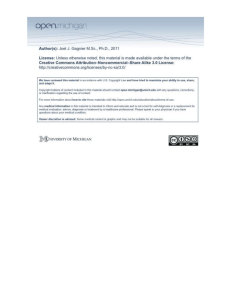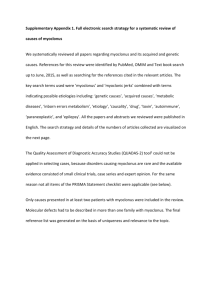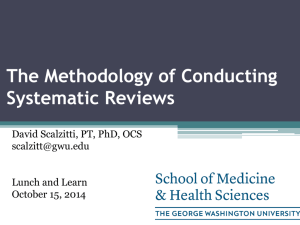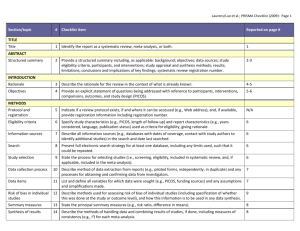Writing a Systematic Literature Review: Resources for Students and
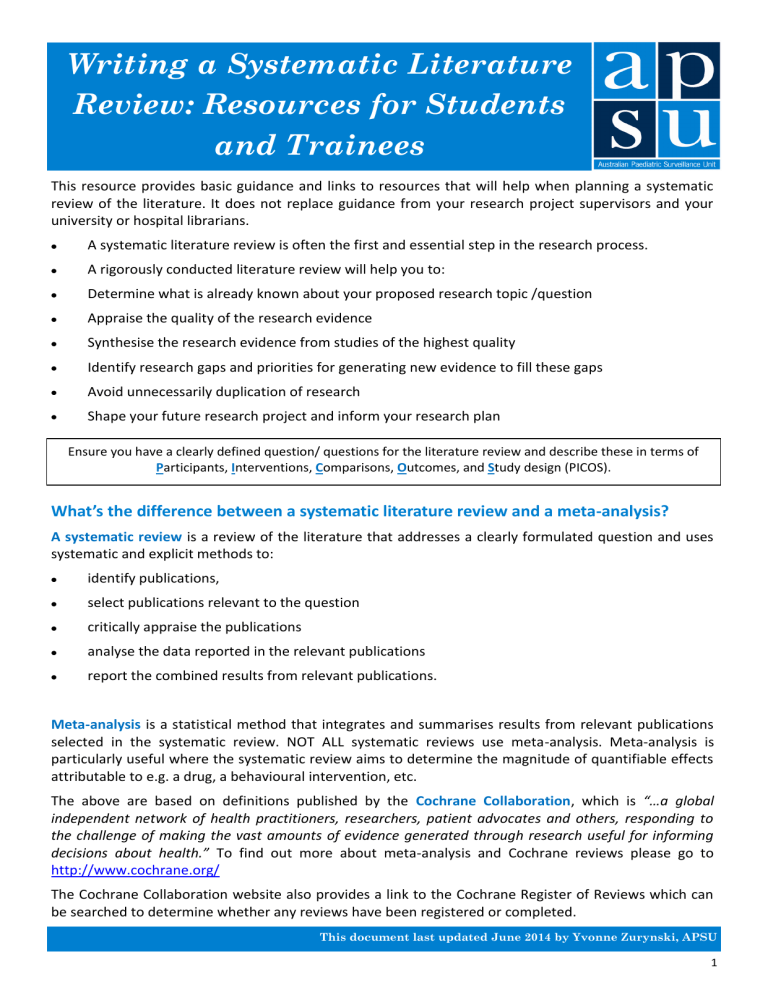
Writing a Systematic Literature
Review: Resources for Students and Trainees
This resource provides basic guidance and links to resources that will help when planning a systematic review of the literature. It does not replace guidance from your research project supervisors and your university or hospital librarians.
A systematic literature review is often the first and essential step in the research process.
A rigorously conducted literature review will help you to:
Determine what is already known about your proposed research topic /question
Appraise the quality of the research evidence
Synthesise the research evidence from studies of the highest quality
Identify research gaps and priorities for generating new evidence to fill these gaps
Avoid unnecessarily duplication of research
Shape your future research project and inform your research plan
Ensure you have a clearly defined question/ questions for the literature review and describe these in terms of
P articipants, I nterventions, C omparisons, O utcomes, and S tudy design (PICOS).
What’s the difference between a systematic literature review and a meta-analysis?
A systematic review is a review of the literature that addresses a clearly formulated question and uses systematic and explicit methods to: identify publications, select publications relevant to the question critically appraise the publications analyse the data reported in the relevant publications report the combined results from relevant publications.
Meta-analysis is a statistical method that integrates and summarises results from relevant publications selected in the systematic review. NOT ALL systematic reviews use meta-analysis. Meta-analysis is particularly useful where the systematic review aims to determine the magnitude of quantifiable effects attributable to e.g. a drug, a behavioural intervention, etc.
The above are based on definitions published by the Cochrane Collaboration , which is “…a global independent network of health practitioners, researchers, patient advocates and others, responding to the challenge of making the vast amounts of evidence generated through research useful for informing decisions about health.” To find out more about meta-analysis and Cochrane reviews please go to http://www.cochrane.org/
The Cochrane Collaboration website also provides a link to the Cochrane Register of Reviews which can be searched to determine whether any reviews have been registered or completed.
This document last updated June 2014 by Yvonne Zurynski, APSU
1
Writing a Systematic Literature
Review: Resources for Students and Trainees
Some key resources are highlighted in the next few pages – researchers around the world have found these useful – it’s worth a look and it might save you a lot of time!
Keep these tips in mind:
1. Define your question clearly (remember PICOS); discuss with your supervisor and colleagues
2. Write a brief protocol according to guidelines for systematic reviews (e.g. PRISMA or Cochrane)
3. Talk with a librarian once you have a draft protocol
4. Search literature databases using agreed MeSH headings and key words
Save all search strategies and limits used – you will need to report these
Use EndNote or similar to manage the references you found, cite as you write
5. Always ASK YOUR SUPERVISOR OR YOUR UNIVERSITY/HOSPITAL LIBRARIAN for help
PRISMA: P referred R eporting I tems for S ystematic reviews and M etaA nalyses: the PRISMA statement
(Moher et. al. 2009) http://www.prisma-statement.org/statement.htm
The PRISMA statement is essential reading before starting a systematic literature review. Editors increasingly expect authors of systematic reviews to use PRISMA or similar guidelines.
The PRISMA checklist will guide you on HOW to develop a systematic review protocol and WHAT to include when writing up your review. In your protocol you should set down a clear method including:
Databases to be searched; additional sources used e.g. scanning bibliographies of relevant articles
MeSH terms or key words to be used in the search strategy
Limits applied e.g. published between 2004 and 2013; English language; children < 18 years
Screening process e.g. scanning titles and abstracts for relevance according to inclusion and exclusion criteria
Data to be extracted from the relevant articles identified
Summary data to be reported – this must be closely linked with the initial aims or “questions” of the literature review
All systematic reviews should include a Flow Diagram to demonstrate how many publications were identified and screened for eligibility, how many publications were excluded and why. The PRISMA website provides excellent resources including a checklist and an example of a flow diagram.
The PRISMA Checklist and Flow Diagram is attached to the end of this guide. You will also find these resources on the PRISMA website.
This document last updated June 2014 by Yvonne Zurynski, APSU
2
Writing a Systematic Literature
Review: Resources for Students and Trainees
PROSPERO: University of York Centre for Reviews and Dissemination http://www.crd.york.ac.uk/PROSPERO/
PROSPERO is a register of systematic reviews. It provides links to useful resources about different kinds of reviews. It also provides a searchable database of registered reviews. When embarking on a systematic review, it is wise to search PROSPERO and Cochrane databases for any registered reviews to ensure that you are not duplicating efforts.
EQUATOR Network: E nhancing the Q UAlity and T ransparency O f health R esearch http://www.equator-network.org/
The EQUATOR Network strives to improve the reliability and value of medical research literature by promoting transparent and accurate reporting of research studies. There are useful toolkits for authors reporting on health research including a toolkits on reporting systematic literature reviews http://www.equator-network.org/toolkits/
Searching the literature
Your supervisor should provide guidance regarding access to library services, including access to databases of literature. The most commonly used databases include:
Medline / PubMed http://www.ncbi.nlm.nih.gov/pubmed (this resource is free)
Useful Medline/PubMed resources: http://www.nlm.nih.gov/bsd/pmresources.html
SCOPUS http://www.scopus.com/
Web of Science http://thomsonreuters.com/thomson-reuters-web-of-science/
SCOPUS and Web of Science are available via your university portal or the Hospital library portal.
Clinical Information Access Portal (CiAP) http://www.ciap.health.nsw.gov.au/home.html
is a portal through which you can access a number of literature databases and other resources (eg. Medline,
PsychInfo, BMJ Best practice). CIAP is available to all NSWHealth employees.
This document last updated June 2014 by Yvonne Zurynski, APSU
3
Writing a Systematic Literature
Review: Resources for Students and Trainees
Managing your references
Using reference management software will enable you to:
Categorise the articles identified in your search – you can create groups of articles that answer specific questions
Cite as you write – insert citations in a predetermined format in your report or paper as you write
Generate a list of references cited in your report according to a predefined format eg. Vancouver
Commonly used reference management software:
EndNote http://endnote.com/ there is a cost – most universities and possibly some hospital libraries provide access for free – check with your supervisor or local librarian
RefMan http://www.refman.com/ there is a cost for this – some universities / hospitals provide access to RefMan
A comparison of reference management software is published here: http://www.libraries.psu.edu/psul/lls/choose_citation_mgr.html
OTHER RESOURCES
Peat J, Mellis C, Williams K, Xuan W. Health Science Research: A handbook of Quantitative Methods.
Allen and Unwin, 2001 (especially chapter 1)
Bernard Becker Medical Library, Washington Medical School of Medicine, St. Louis http://beckerguides.wustl.edu/SystematicReviews
Duke University http://guides.mclibrary.duke.edu/sysreview
University of Edinburgh Centre for Cognitive Ageing & Cognitive Epidemiology http://www.ccace.ed.ac.uk/research/software-resources/systematic-reviews-and-meta-analyses
This document last updated June 2014 by Yvonne Zurynski, APSU
4
Section/topic
TITLE
Title
ABSTRACT
Structured summary
INTRODUCTION
Rationale
Objectives
METHODS
Protocol and registration
Eligibility criteria
Information sources
Search
Study selection
Data collection process
Data items
Risk of bias in individual studies
Summary measures
# Checklist item
1 Identify the report as a systematic review, meta-analysis, or both.
2 Provide a structured summary including, as applicable: background; objectives; data sources; study eligibility criteria, participants, and interventions; study appraisal and synthesis methods; results; limitations; conclusions and implications of key findings; systematic review registration number.
3 Describe the rationale for the review in the context of what is already known.
4 Provide an explicit statement of questions being addressed with reference to participants, interventions, comparisons, outcomes, and study design (PICOS).
5 Indicate if a review protocol exists, if and where it can be accessed (e.g., Web address), and, if available, provide registration information including registration number.
6 Specify study characteristics (e.g., PICOS, length of follow-up) and report characteristics (e.g., years considered, language, publication status) used as criteria for eligibility, giving rationale.
7 Describe all information sources (e.g., databases with dates of coverage, contact with study authors to identify additional studies) in the search and date last searched.
8 Present full electronic search strategy for at least one database, including any limits used, such that it could be repeated.
9 State the process for selecting studies (i.e., screening, eligibility, included in systematic review, and, if applicable, included in the meta-analysis).
10 Describe method of data extraction from reports (e.g., piloted forms, independently, in duplicate) and any processes for obtaining and confirming data from investigators.
11 List and define all variables for which data were sought (e.g., PICOS, funding sources) and any assumptions and simplifications made.
12 Describe methods used for assessing risk of bias of individual studies (including specification of whether this was done at the study or outcome level), and how this information is to be used in any data synthesis.
13 State the principal summary measures (e.g., risk ratio, difference in means).
Reported on page #
5
Synthesis of results
Risk of bias across studies
Additional analyses
RESULTS
Study selection
14 Describe the methods of handling data and combining results of studies, if done, including measures of consistency (e.g., I
2
) for each metaanalysis.
15 Specify any assessment of risk of bias that may affect the cumulative evidence (e.g., publication bias, selective reporting within studies).
16 Describe methods of additional analyses (e.g., sensitivity or subgroup analyses, meta-regression), if done, indicating which were pre-specified.
Study characteristics
17 Give numbers of studies screened, assessed for eligibility, and included in the review, with reasons for exclusions at each stage, ideally with a flow diagram.
18 For each study, present characteristics for which data were extracted (e.g., study size, PICOS, follow-up period) and provide the citations.
Risk of bias within studies
Results of individual studies
Synthesis of results
Risk of bias across studies
Additional analysis
DISCUSSION
Summary of evidence
19 Present data on risk of bias of each study and, if available, any outcome level assessment (see item 12).
20 For all outcomes considered (benefits or harms), present, for each study: (a) simple summary data for each intervention group (b) effect estimates and confidence intervals, ideally with a forest plot.
21 Present results of each meta-analysis done, including confidence intervals and measures of consistency.
22 Present results of any assessment of risk of bias across studies (see Item 15).
23 Give results of additional analyses, if done (e.g., sensitivity or subgroup analyses, meta-regression [see Item 16]).
Limitations
24 Summarize the main findings including the strength of evidence for each main outcome; consider their relevance to key groups (e.g., healthcare providers, users, and policy makers).
25 Discuss limitations at study and outcome level (e.g., risk of bias), and at review-level (e.g., incomplete retrieval of identified research, reporting bias).
26 Provide a general interpretation of the results in the context of other evidence, and implications for future research. Conclusions
FUNDING
Funding 27 Describe sources of funding for the systematic review and other support (e.g., supply of data); role of funders for the systematic review.
From: Moher D, Liberati A, Tetzlaff J, Altman DG, The PRISMA Group (2009). Preferred Reporting Items for Systematic Reviews and Meta-Analyses: The PRISMA Statement. PLoS Med 6(6): e1000097. doi:10.1371/journal.pmed1000097 For more information, visit: www.prisma-statement.org
6
PRISMA 2009 Flow Diagram
From: Moher D, Liberati A, Tetzlaff J, Altman DG, The PRISMA Group (2009). P referred R eporting I tems for S ystematic Reviews and M eta-
A nalyses: The PRISMA Statement. PLoS Med 6(6): e1000097. doi:10.1371/journal.pmed1000097
For more information, visit www.prisma-statement.org
.
Records identified through database searching
(n = )
Additional records identified through other sources
(n = )
Records after duplicates removed
(n = )
Records screened
(n = )
Full-text articles assessed for eligibility
(n = )
Studies included in qualitative synthesis
(n = )
Studies included in quantitative synthesis
(meta-analysis)
(n = )
Records excluded
(n = )
Full-text articles excluded, with reasons
(n = )
7
